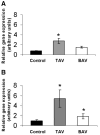Basal and oxidative stress-induced expression of metallothionein is decreased in ascending aortic aneurysms of bicuspid aortic valve patients
- PMID: 19398671
- PMCID: PMC5268483
- DOI: 10.1161/CIRCULATIONAHA.108.770776
Basal and oxidative stress-induced expression of metallothionein is decreased in ascending aortic aneurysms of bicuspid aortic valve patients
Abstract
Background: Bicuspid aortic valve (BAV) is a heritable condition that has been linked by an unknown mechanism to a predisposition for ascending aortic aneurysm. Matrix metalloproteinases have been implicated in this predisposition. Metallothionein is a poorly characterized, metal-binding protein that regulates matrix metalloproteinases and is an antioxidant known to be upregulated under oxidative stress.
Methods and results: To determine putative factors involved in the pathogenesis of aortic aneurysm in BAV patients, our first goal was to identify genes that are dysregulated in ascending aortic aneurysms of BAV patients compared with tricuspid aortic valve patients and nondiseased (control) donors. By microarray analysis (22,000 probe sets), 110 dysregulated genes were identified in BAV compared with tricuspid aortic valve patients and control donors; 8 were genes of the metallothionein family. Metallothionein gene expression and protein expression were significantly lower in aortic tissue and cultured aortic smooth muscle cells from BAV patients compared with control subjects. Matrix metalloproteinase-9 expression was increased in BAV aortic samples relative to controls. BAV aorta was more susceptible to oxidative stress, and induction of metallothionein under oxidative stress was reduced in BAV patients compared with control subjects.
Conclusions: These results demonstrate dysregulated metallothionein expression in ascending aortic smooth muscle cells of BAV patients that may contribute to an inadequate response to oxidative stress and provoke aneurysm formation. We hypothesize that metallothionein plays a pivotal role in the response of ascending aortic smooth muscle cells to oxidative stress cues normally involved in the maintenance of the extracellular matrix, including the regulation of matrix metalloproteinase expression.
Figures





Comment in
-
Metallothionein link to bicuspid aortic valve-associated ascending aortic dilatation.Circulation. 2009 May 12;119(18):2423-5. doi: 10.1161/CIRCULATIONAHA.109.858308. Circulation. 2009. PMID: 19433767 No abstract available.
References
-
- Nataatmadja M, West M, West J, Summers K, Walker P, Nagata M, Watanabe T. Abnormal extracellular matrix protein transport associated with increased apoptosis of vascular smooth muscle cells in Marfan syndrome and bicuspid aortic valve thoracic aortic aneurysm. Circulation. 2003;108(suppl II):II-329–II-334. - PubMed
-
- Gleason TG. Heritable disorders predisposing to aortic dissection. Semin Thorac Cardiovasc Surg. 2005;17:274–281. - PubMed
-
- Fedak PW, de Sa MP, Verma S, Nili N, Kazemian P, Butany J, Strauss BH, Weisel RD, David TE. Vascular matrix remodeling in patients with bicuspid aortic valve malformations: implications for aortic dilatation. J Thorac Cardiovasc Surg. 2003;126:797–806. - PubMed
-
- Fedak PW, Verma S, David TE, Leask RL, Weisel RD, Butany J. Clinical and pathophysiological implications of a bicuspid aortic valve. Circulation. 2002;106:900–904. - PubMed
Publication types
MeSH terms
Substances
Grants and funding
LinkOut - more resources
Full Text Sources
Other Literature Sources
Medical

